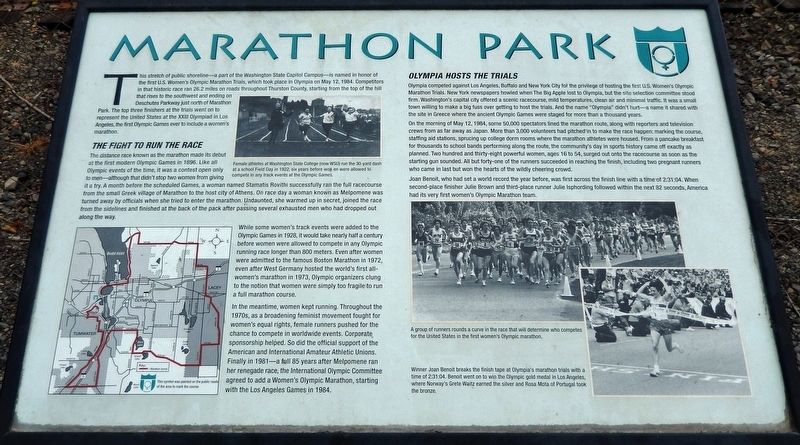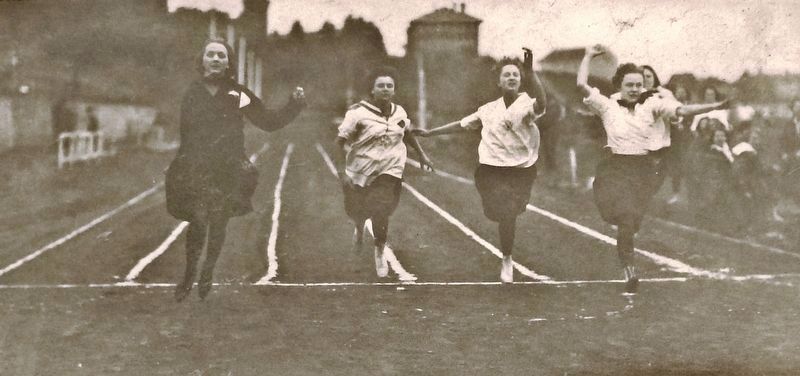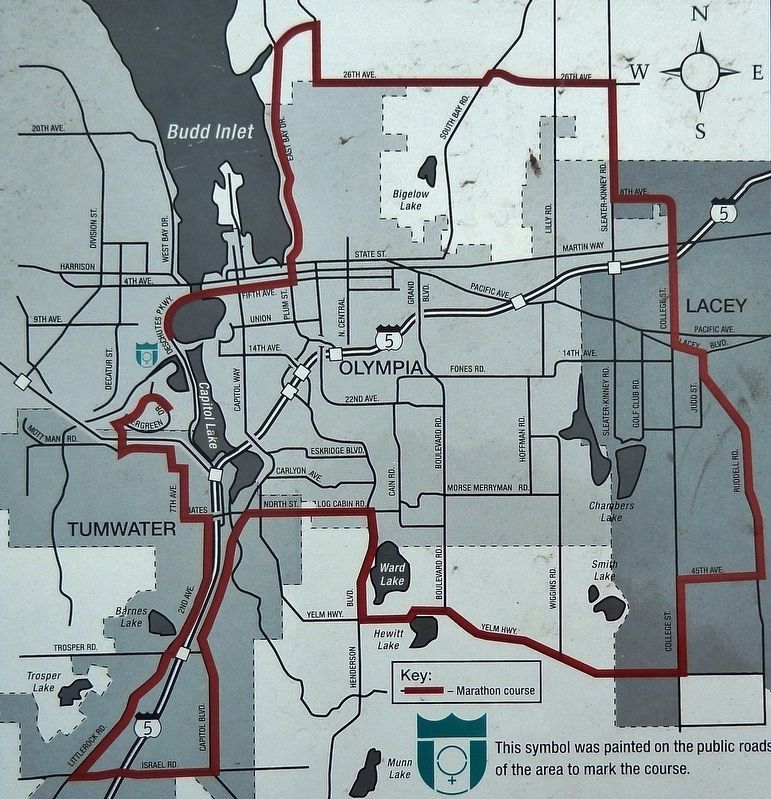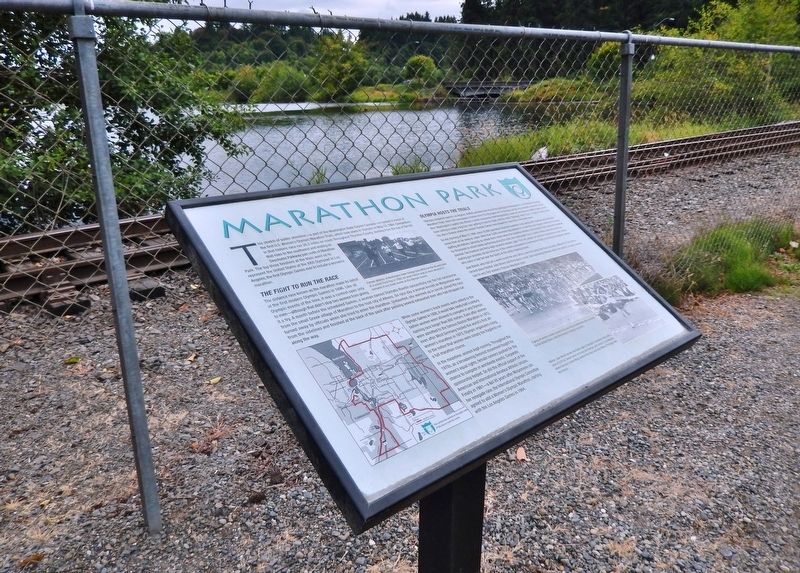Olympia in Thurston County, Washington — The American West (Northwest)
Marathon Park
The Fight to Run the Race
The distance race known as the marathon made its debut at the first modern Olympic Games in 1896. Like all Olympic events of the time, it was a contest open only to men—although that didn't stop two women from giving it a try. A month before the scheduled Games, a woman named Stamatis Rovithi successfully ran the full racecourse from the small Greek village of Marathon to the host city of Athens. On race day a woman known as Melpomene was turned away by officials when she tried to enter the marathon. Undaunted, she warmed up in secret, joined the race from the sidelines and finished at the back of the pack after passing several exhausted men who had dropped out along the way.
While some women’s track events were added to the Olympic Games in 1928, it would take nearly half a century before women were allowed to compete in any Olympic running race longer than 800 meters. Even after women were admitted to the famous Boston Marathon in 1972, even after West Germany hosted the world’s first all-women’s marathon in 1973, Olympic organizers clung to the notion that women were simply too fragile to run a full marathon course.
In the meantime, women kept running. Throughout the 1970s, as a broadening feminist movement fought for women’s equal rights, female runners pushed for the chance to compete in worldwide events. Corporate sponsorship helped. So did the official support of the American and International Amateur Athletic Unions. Finally in 1981—a full 85 years after Melpomene ran her renegade race, the International Olympic Committee agreed to add a Women’s Olympic Marathon, starting with the Los Angeles Games in 1984.
Olympia Hosts the Trials
Olympia competed against Los Angeles, Buffalo and New York City for the privilege of hosting the first U.S. Women’s Olympic Marathon Trials. New York newspapers howled when The Big Apple lost to Olympia, but the site selection committee stood firm. Washington’s capital city offered a scenic racecourse, mild temperatures, clean air and minimal traffic. It was a small town willing to make a big fuss
over getting to host the trials. And the name “Olympia” didn't hurt—a name it shared with the site in Greece where the ancient Olympic Games were staged for more than a thousand years.
On the morning of May 12, 1984, some 50,000 spectators lined the marathon route, along with reporters and television crews from as far away as Japan. More than 3,000 volunteers had pitched in to make the race happen: marking the course, staffing aid stations, sprucing up college dorm rooms where the marathon athletes were housed. From a pancake breakfast for thousands to school bands performing along the route, the community’s day in sports history came off exactly as planned. Two hundred and thirty-eight powerful women, ages 16 to 54, surged out onto the racecourse as soon as the starting gun sounded. All but forty-one of the runners succeeded in reaching the finish, including two pregnant runners who came in last but won the hearts of the wildly cheering crowd.
Joan Benoit, who had set a world record the year before, was first across the finish line with a time of 2:31:04. When second-place finisher Julie Brown and third-place runner Julie Isphording followed within the next 82 seconds, America had its very first women's Olympic Marathon team.
Topics. This historical marker is listed in these topic lists: Notable Events • Sports • Women. A significant historical date for this entry is May 12, 1984.
Location. 47° 2.213′ N, 122° 54.677′ W. Marker is in Olympia, Washington, in Thurston County. Marker can be reached from Deschutes Parkway Southwest, 0.6 miles south of 5th Avenue Southwest, on the left when traveling south. Marker is located in Marathon Park, at the trailhead, along the walkway at the east end of the parking lot. Touch for map. Marker is at or near this postal address: 1011 Deschutes Parkway SW, Olympia WA 98501, United States of America. Touch for directions.
Other nearby markers. At least 8 other markers are within walking distance of this marker. Washington's State Capitol Design (approx. 0.3 miles away); POW AND MIA Monument (approx. 0.4 miles away); The First William Winlock Miller High School (approx. 0.4 miles away); The Medal of Honor Monument (approx. 0.4 miles away); Putting down roots (approx. 0.4 miles away); Sequoia Tree (approx. half a mile away); Thurston County (approx. half a mile away); The Lone Tree (approx. 0.6 miles away). Touch for a list and map of all markers in Olympia.
More about this marker. Marker is a large, framed composite plaque mounted horizontally on a waist-high metal post.
Also see . . . The 1984 Los Angeles Olympics: A Run to Glory.
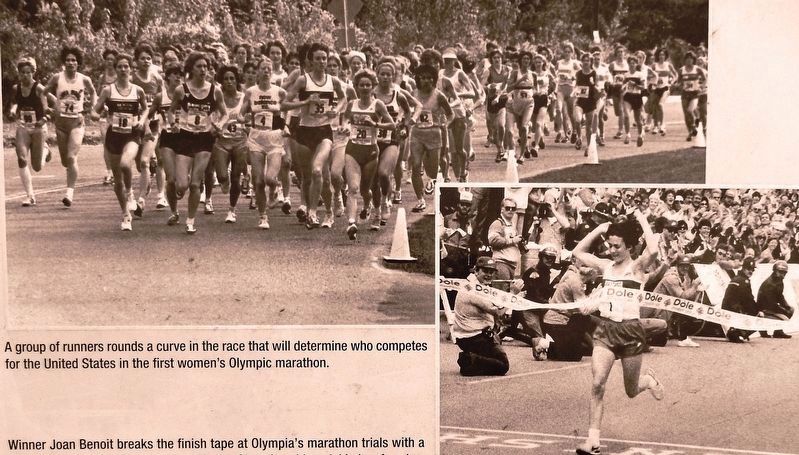
4. Marker detail: First Women's Olympic Marathon
A group of runners rounds a curve in the race that will determine who competes for the United States in the first women’s Olympic marathon.
Winner Joan Benoit breaks the finish tape at Olympia’s marathon trials with a time of 2:31:04. Benoit went on to win the Olympic gold medal in Los Angeles, where Norway’s Grete Waitz earned the silver and Rosa Mota of Portugal took the bronze.
Winner Joan Benoit breaks the finish tape at Olympia’s marathon trials with a time of 2:31:04. Benoit went on to win the Olympic gold medal in Los Angeles, where Norway’s Grete Waitz earned the silver and Rosa Mota of Portugal took the bronze.
Credits. This page was last revised on January 17, 2019. It was originally submitted on January 14, 2019, by Cosmos Mariner of Cape Canaveral, Florida. This page has been viewed 346 times since then and 34 times this year. Photos: 1, 2, 3, 4, 5. submitted on January 14, 2019, by Cosmos Mariner of Cape Canaveral, Florida. • Andrew Ruppenstein was the editor who published this page.
